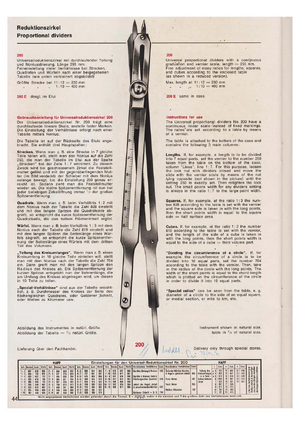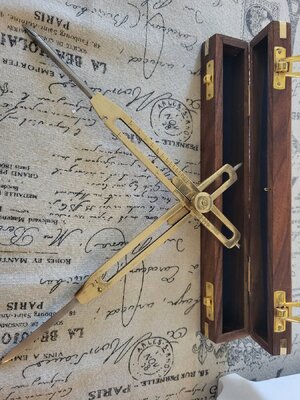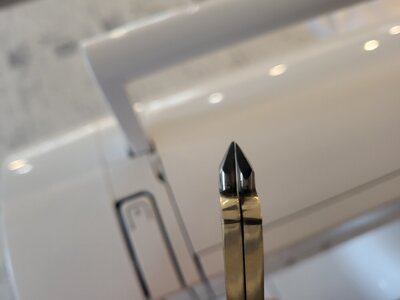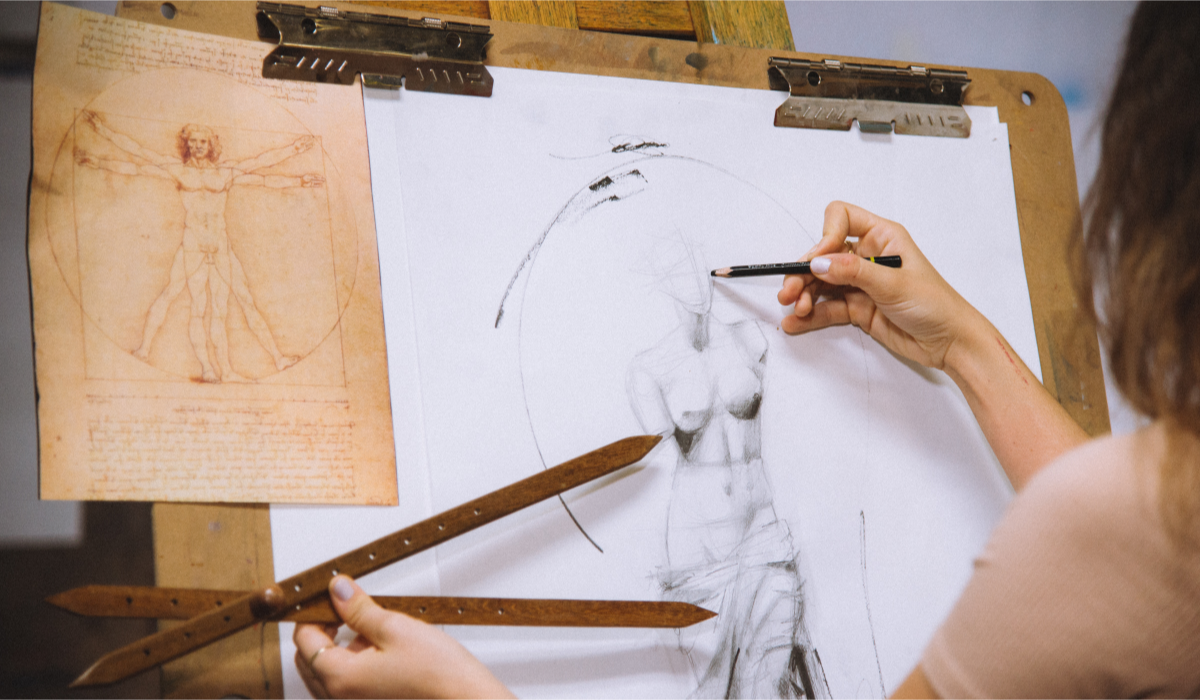The proportional dividers pictured by the OP are an inexpensive set most likely made in India or Pakistan for the brass curio trade. They are not "professional grade," but may be sufficient for modeling purposes. They are scaled for proportions in "multiples," "times two, times three," and so on. A professional grade set of proportional dividers will be made of German silver and those scaled for modeling will invariably be ten inches long over all. There are shorter models, commonly 6", 7", and 8" which are "useable," but lack the accuracy possible with the full size "universal" models scaled to set proportions in terms of their decimal equivalents. There are also very large, and for our purposes crude, proportional dividers used by artists and sculptors, which are too large to be useful for modeling purposes. If you have a proportional divider regardless of the scaling on the instrument, you can always "manually" set the proportion by drawing two lines of proportionate length (e.g. 1" and 2" long for 1:2 proportion) and adjusting the dividers so that the points on each end are set to exactly match the length of the respective lines. The divider will then be set to the proportion of the two lines.
I find proportional dividers essential because I find myself redrawing lines published in old books (Chapelle, etc.) that will be prints of larger drawings reproduced in the book, often without regard to scale. With a good set of proportional dividers, all you need is a single identified measurement on the original drawing (a scale is often included in the original drawing) and with your dividers set to your desired drawing scale, away you go! Just take a distance from the page in the book and the other side of the dividers gives you the distance to the scale you've set for your drawing. There are, as mentioned, a lot of other things you can do with them as well, such as drawing a square with the same area as a particular circle and vice versa, but I've yet to learn who really needs to do that. They are very handing for dividing lengths into equal increments for spacing planking runs, ratline spacing, stanchion spacing, and such.
I collect fine drafting instruments for my own use. Most I've bought on eBay and I check for listings frequently and note that the prices do vary wildly, depending on condition, quality and rarity. Condition may not always be a relevant factor if you are looking for a "user." Some oaf may have scratched his name into the instrument and/or the case may be in rough shape or missing. That can mean a $100 or $150 reduction, leaving what would be a "mint" $200 instrument going for only $50, yet be entirely satisfactory for use, nonetheless. Be forewarned that I started collecting mint condition examples of the finest manual drafting instruments made, primarily Keuffel and Esser's Paragon line, made in Germany and solid in the U.S., as far back as twenty years ago when CAD had almost completely replaced manual drafting in the professional workplace and manual drafting instruments were plentiful and not in demand. An active collectors' market has since developed, and prices have risen accordingly for the more desirable instruments which are now much less available. Alas, the really excellent examples are no longer manufactured.
The proportional dividers that you want to obtain for modeling use are the 10" pairs with "110 scaling" or "decimal scaling." These are referred to in the advertising literature as "universal proportional dividers" because with decimal scaling they can be used for any purpose possible rather than those scaled only for specific purposes like navigation. This universal scaling permits setting proportions in "decimal equivalents" (e.g. 1/2 = .50) These instruments will have rack and pinion geared adjustment and Vernier adjustment to decimals out to .0005 (If memory serves... perhaps there's an extra zero in there... don't hold me to it.) These instruments will be manufactured by Keuffel and Esser, Dietzgen, Post, and Bowen (among less commonly seen other brands) in straight point and right-angle point configurations (as pictured in post #2 above.) (You will likely never see a right angle pointed set on EBay. They are extremely rare.) The most commonly offered are the K&E 10" "Paragon" decimal scaled models. "Paragon" was K&E's top of the line series of instruments and the "110" decimal equivalent scaled dividers were only offered in the "Paragon" line. They are made of cold rolled "German silver," an alloy of nickel and copper, much similar to Monel and were hand fitted, each bearing matching part serial numbers. They were sold in silk velvet lined fitted cases. The back of the case in newer production models has a metal plate on the bottom with all the various decimal equivalents etched in it, which is quite helpful. Older models have a cardboard insert (often missing) that has the same information. (The information is easily found on line in any event and decimal equivalents are easily calculated on by a simple math formula or on any smart phone calculator.)
 There are also commonly 6" and 7.5" proportional dividers. The 7.5" models do come with rack and pinion adjustment but not with the more accurate Vernier adjustment feature. They are, however, useable. The 6" models do not have rack and pinion adjustment and neither do some of the 7.5" models. Don't waste your money on anything that does not have rack and pinion adjustment. While useable, the "slide" adjustment models aren't anywhere near as accurate. Similarly, pay the few extra bucks for the "110" decimal scaling. The other proportional dividers have scaling that corresponds to fractions 1/2, 1/3, 1/4 and so on, and settings in between are "by guess and by golly." Also, you will see "Russian Navy" and "Weems and Plath" proportional dividers offered. Take a pass on these because they are "navigational dividers" and, although they work the same and are useable, they are scaled for "time" and "distance" proportions for use on maps and their scaling isn't useful for modeling measurement conversions. (You can adjust them for plans measurement conversions by comparison to a rule and/or tick strips, but this is rather tedious)
There are also commonly 6" and 7.5" proportional dividers. The 7.5" models do come with rack and pinion adjustment but not with the more accurate Vernier adjustment feature. They are, however, useable. The 6" models do not have rack and pinion adjustment and neither do some of the 7.5" models. Don't waste your money on anything that does not have rack and pinion adjustment. While useable, the "slide" adjustment models aren't anywhere near as accurate. Similarly, pay the few extra bucks for the "110" decimal scaling. The other proportional dividers have scaling that corresponds to fractions 1/2, 1/3, 1/4 and so on, and settings in between are "by guess and by golly." Also, you will see "Russian Navy" and "Weems and Plath" proportional dividers offered. Take a pass on these because they are "navigational dividers" and, although they work the same and are useable, they are scaled for "time" and "distance" proportions for use on maps and their scaling isn't useful for modeling measurement conversions. (You can adjust them for plans measurement conversions by comparison to a rule and/or tick strips, but this is rather tedious)
All K&E
Paragon instruments are labeled "
Paragon."

Note rack and pinion Vernier adjustment, and decimal scaling.
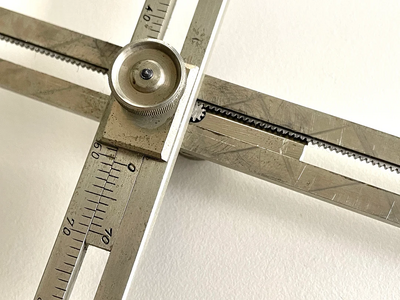
Very early "right-angle point" K&E
Paragon branded universal proportional divider in old style case. No difference in function. Just a matter of style.

Early 20th century K&E Paragon branded 10" Universal Proportional Dividers.

Post branded universal proportional divider in pin-lock case.

Mid-20th century K&E Universal Proportional Divider in hard case with decimal equivalent and formulae chart on back. (Most commonly encountered type now.)

Very late manufacture K&E Paragon 10" universal proportional divider packaged as their "Mark I" line. Manufactured by Haff Instruments
 In summary, what you want to look for on eBay is a Keuffel and Esser 10" "Paragon" proportional divider with "110" decimal scaling. They are relatively common because they were the "professional's choice" for many years. A "mint" example with an excellent case will sell for as much as $225, but very "clean" examples regularly go for around $125 at the moment. Examples that are a bit "rough," mainly due to a worn case, can be had for $75 or even $50.
In summary, what you want to look for on eBay is a Keuffel and Esser 10" "Paragon" proportional divider with "110" decimal scaling. They are relatively common because they were the "professional's choice" for many years. A "mint" example with an excellent case will sell for as much as $225, but very "clean" examples regularly go for around $125 at the moment. Examples that are a bit "rough," mainly due to a worn case, can be had for $75 or even $50.
If you work from drawings to the scale you are building (i.e. as with kit plans,) you can live without a proportional divider, but if you are working from plans in one scale (or no scale, as in many lines drawings found in old books,) you will be amazed at how you ever before lived without them. Yes, you can measure a distance and then punch that into a calculator and then measure off the result, over and over again, or you can set your proportional dividers once and then simply measure the drawing at one end of the dividers and have the proportional distance simultaneously provided between the points of the other end of the dividers. It doesn't get any faster or simpler than that.
Haff drafting instruments company advertising page and instructions for use of Universal Proportional Dividers. The finest, and near-only, drafting instrument manufacturers in the world were a handful of companies in Germany and Switzerland. One of these, Haff, made all of K&E's
Paragon line, labeled for sale in the U.S. under the K&E label. As the prices were stated in euros, this advertisement was after 1999. Twenty-five years ago or so, they wanted 200 euros or about $200 for one retail.
